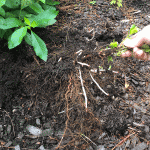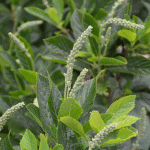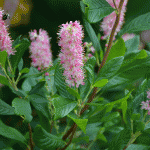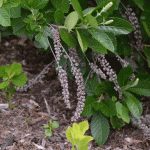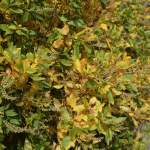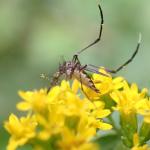A monthly e-newsletter from UMass Extension for landscapers, arborists, and other Green Industry professionals, including monthly tips for home gardeners.
To read individual sections of the message, click on the section headings below to expand the content.
To print this issue, either press CTRL/CMD + P or right click on the page and choose Print from the pop-up menu.
Hot Topics
Registration for our 2022 Green School has Begun!
UMass Extension’s Green School is a comprehensive 60+ hour certificate short course that offers fundamental horticultural training in a compact time frame.
Who Should Attend? Professional practitioners such as landscapers, lawn care providers, nursery operators, sports field managers, public and private grounds managers, arborists, professional gardeners, landscape and garden designers, and others in the green industries. Both experienced individuals as well as those aspiring to be will benefit from this course.
Where? Entirely virtual in 2022, taught by UMass Extension Specialists, UMass faculty, and distinguished guest instructors.
When? Tuesday, Wednesday and Thursday afternoons 1:00 to 4:30 pm from 10/25/2022 thru 12/15/2022.
How? The curriculum emphasizes a systems-based approach to plant and land care based on current research and is built on a framework of Best Management Practices (BMPs) and Integrated Pest Management (IPM).
Choose from three specialty tracks:
- Landscape Management
- Turf Management
- Arboriculture
For complete information, detailed schedules and registration options, go to https://ag.umass.edu/landscape/education/umass-extensions-green-school
Why Choose Green School?
- A robust alternative or a stepping stone to a more involved degree program.
- Convenient yet rigorous remote learning from the comfort of your home or office.
- In-depth, research-based training for skills that are in high demand, and are applicable to active and engaging outdoor work.
- Three educational track options to fit your personal goals.
- Structured interaction with University educators and researchers.
- Competitive fees and tuition assistance options.
- An established program with a 30+ year history and a certificate that carries weight in the industry.
Move your career or business forward, and achieve better results with a smaller overall impact!
State Agricultural Officials Ask Public to be on Alert for Invasive Spotted Lanternfly Nymphs
The Massachusetts Department of Agricultural Resources (MDAR) is asking the public to keep an eye out for the invasive pest known as spotted lanternfly (Lycorma delicatula) due to the risk of egg masses being accidentally brought in on shipments of trees imported from other states. Earlier this spring, MDAR received reports that nursery stock from SLF-infested areas may have been sent to Massachusetts growers. Due to this, anyone who has recently purchased trees or shrubs or had them planted on their property, particularly maple or crabapple trees, is being asked to inspect the trunk and branches to ensure there are no SLF egg masses or any hitchhiking nymphs, and to report any finds to MDAR. For more details, go to https://www.mass.gov/news/state-agricultural-officials-ask-public-to-be-on-alert-for-hatching-of-invasive-spotted-lanternfly-eggs
The MA Department of Agricultural Resources (MDAR) also reminds those in the nursery and landscape industry to inspect any material coming from states where the spotted lanternfly has been found. To read the full notice, go to: https://massnrc.org/pests/blog/?p=2933
Established spotted lanternfly populations have (to date) only been detected in Worcester County, MA in the communities of Fitchburg and Shrewsbury, MA. Professionals and residents working and living in those areas should be vigilant and report anything suspected to be the spotted lanternfly to the MA Department of Agricultural Resources at https://massnrc.org/pests/slfreport.aspx . Everyone in Massachusetts should be looking for and reporting this insect if it is found.
Now is the time when spotted lanternfly egg masses will have hatched and nymphs (immatures) will be active.
For More Information about the Spotted Lanternfly
From UMass Extension:
- Check out the InsectXaminer Episode about spotted lanternfly adults and egg masses!
- UMass Extension Spotted lanternfly fact sheet
From the MA Department of Agricultural Resources:
Featured Plant
Clethra alnifolia - Summersweet or Sweet Pepperbush
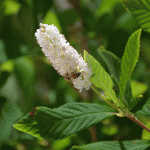 Looking for a native shrub with fragrant flowers, that’s popular with pollinators and wildlife, and blooms in the shade? Look no further than Clethra alnifolia!
Looking for a native shrub with fragrant flowers, that’s popular with pollinators and wildlife, and blooms in the shade? Look no further than Clethra alnifolia!
Clethra alnifolia (Summersweet) is a small to medium, deciduous shrub native the costal swamps of the eastern United States from Texas to Maine. The species is upright growing, 3-8’ tall and 4-6’ wide. Cultivars offer smaller, often more rounded forms. Plants are colonizing, spreading by underground stolons. Control of stolons by pruning is needed if spreading is not desired.
The main attraction of Summersweet is the 3-6” long upright panicles (racemes) of fragrant white flowers that cover the plant from mid to late summer. Flowers give way to brown seed capsules that persist into winter. The capsules resemble peppercorns and have provided the other common name of sweet pepperbush. Capsules are also useful for identification in winter. Plants are late to leaf out in spring. Leaves are oblong, glossy dark green with serrated margins. Fall color is mixed, sometimes golden yellow, other times a mix of yellow and brown.
Clethra alnifolia can be planted in full sun to part shade, tolerating and still flowering even in heavy shade. It prefers a moist soil but can tolerate drought once established. It is often found in sandy soils in its native habitat. It has no serious insect or disease problems.
A preference for moist soil makes it a good choice around ponds, water gardens, and rain gardens, but it is also good in mass plantings, shrub borders, or even foundation plantings. Summersweet can also be used as a deciduous screen or hedge. It should be planted where the fragrant flowers can be appreciated; however, it should be kept in mind that the flowers are very popular with bees.
Cultivars:
- “Rosea’ – pink flowers that age to white, similar in size to species
- ‘Ruby Spice’ - Rose pink flowers
- ‘Sixteen Candles’ – upright, candle-like flower spikes, more compact size
- ‘Hummingbird’ – compact, 3-4’, more flowers than species
- ‘Caleb’ – Vanilla Spice – compact size and large flowers (10-12” long)
- ‘Crystalina’ – Sugartina – compact 2-3’ tall and 3-4’ wide
Mandy Bayer, Extension Assistant Professor of Landscape Horticulture
Trouble Maker of the Month
A Large Crabgrass Look-alike: Paspalum setaceum
Species Overview
Becoming more common in landscape and turf settings, Paspalum setaceum is a warm-season, native perennial grass. Most commonly called paspalum among New England green industry professionals, it wins Randy Prostak’s award for too many common names, being also known as thin paspalum, bull paspalum, fringe-leaf paspalum, hairy beadgrass, and slender beadgrass. Paspalum setaceum is found in the United States in the eastern two-thirds of the country, from the Great Plains east to the coast, often with spotty distribution within individual states. It is sometimes incorrectly called dallisgrass (Paspalum dilatatum), which is a closely related grass found in the southeastern United States.
Identification Characteristics
Habitat: Paspalum prefers sandy soil and is typically found in open woods, open ground, old fields, and forest borders. It is tolerant of droughty and/or impoverished soils.
Growth habit: Stems are upright or reclining, slender, somewhat flattened, with smooth nodes.
Leaves: Blades are densely hairy above and below, margins wavy and hairy, rolled in bud; ligule short membrane, sheaths densely haired.
Seedheads: Terminal racemes are usually 1 or 2 branched, sometimes 3. Axillary racemes are usually solitary, straight, or slightly curved, sometimes the sheath is enclosed. Spikelets are usually in pairs, arranged alternately in two rows on one side of the flattened raceme and appressed to the rachis.

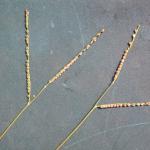
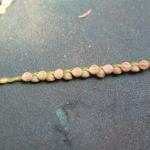 Roots: Fibrous roots, short rhizomes within fibrous roots.
Roots: Fibrous roots, short rhizomes within fibrous roots.
Reproduction: Vegetatively propagated asexually by short rhizomes and sexually by seed. It is not aggressive or a prolific plant as seed production and germination is low.
Management
Turf - Since it is a perennial, preemergence crabgrass herbicides (dithiopyr, mesotrione, pendimethalin and prodiamine) and postemergence herbicides (fenoxaprop, mesotrione and quinclorac) will not provide effective control. For many years, suppression was achieved with MSMA. However, with the loss of MSMA in turf, there was no longer a selective herbicide for the management of paspalum. A few years ago, topramezone, marketed as PylexTM, came to the turf market and provides excellent control of paspalum when applied from early July through early September. In turf areas that are dominated by paspalum and little, if any, desirable turfgrass remains, an application of glyphosate followed by reseeding should be considered.
Landscape - Directed-spray, application of glyphosate should be made from early July through early September. Alternatively, the postemergence, over-the-top, graminicide clethodim can be applied during the same period.
Randy Prostak, UMass Extension Weed Specialist
Q&A
Q. I live in southern Berkshire County and my oak tree has been defoliated by spongy moth (Lymantria dispar) caterpillars for the first time this year. Will it survive?
A. This is a tricky question! While it is never wise to speak in absolute terms when it comes to insect-tree interactions, in general, most otherwise healthy trees can survive a single season of even complete defoliation from spongy moth caterpillars. If an oak tree is otherwise healthy (proper planting, well established, correct site conditions, and no additional abiotic stressors such as drought or flooding), it can typically survive a single season of defoliation. However, if additional stressors are present, or if the tree was also defoliated in 2021, it is possible for branch dieback or even tree mortality to occur. If you have concerns, especially due to safety if a tree is near a home or other structure, contact a qualified arborist to help evaluate your tree.
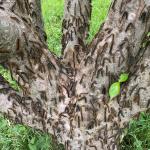 The good news is spongy moth caterpillars are pupating, and therefore the feeding damage from this insect is coming to an end for 2022. Additionally, caterpillar mortality due to the NPV virus and the spongy moth caterpillar killing fungus (Entomophaga maimaiga) has been observed in multiple locations in Berkshire County this year. Now is the time to keep an eye on the adult female moths and the numbers of spongy, tan colored egg masses they are laying on just about any flat surface. The egg masses will overwinter and provide (hopefully fewer) caterpillars in 2023. But only time will tell!
The good news is spongy moth caterpillars are pupating, and therefore the feeding damage from this insect is coming to an end for 2022. Additionally, caterpillar mortality due to the NPV virus and the spongy moth caterpillar killing fungus (Entomophaga maimaiga) has been observed in multiple locations in Berkshire County this year. Now is the time to keep an eye on the adult female moths and the numbers of spongy, tan colored egg masses they are laying on just about any flat surface. The egg masses will overwinter and provide (hopefully fewer) caterpillars in 2023. But only time will tell!
Q. Now that bagworm eggs have hatched and the caterpillars are feeding, what can be done to protect shade trees and ornamentals in managed landscapes?
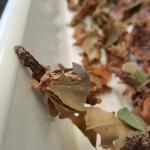 A. The common bagworm (Thyridopteryx ephemeraeformis) is a native insect whose caterpillars feed on the foliage of arborvitae, juniper, cedar, sycamore, maple, locust, boxelder, linden, and London planetree, among many other potential host plants. The larvae of this species create “bags” made from plant foliage, bark, and other plant parts tied together with silk around themselves. Egg hatch occurs in mid-June and caterpillars feed through late summer. By August, caterpillars are large and capable of completely stripping small trees, shrubs, and hedges, particularly in urban forests. If detected now, where practical, bagworm caterpillars can be removed by hand and dropped into a bucket of soapy water. Several natural enemies are important regulators of bagworm populations, so if selecting chemical management strategies, reduced risk options are recommended. Bacillus thuringiensis Kurstaki (Btk) can be used on young, actively feeding larvae. Additional reduced risk active ingredients labelled for use against bagworms include spinosad and chlorantraniliprole. Read and follow all label instructions for safety and proper use.
A. The common bagworm (Thyridopteryx ephemeraeformis) is a native insect whose caterpillars feed on the foliage of arborvitae, juniper, cedar, sycamore, maple, locust, boxelder, linden, and London planetree, among many other potential host plants. The larvae of this species create “bags” made from plant foliage, bark, and other plant parts tied together with silk around themselves. Egg hatch occurs in mid-June and caterpillars feed through late summer. By August, caterpillars are large and capable of completely stripping small trees, shrubs, and hedges, particularly in urban forests. If detected now, where practical, bagworm caterpillars can be removed by hand and dropped into a bucket of soapy water. Several natural enemies are important regulators of bagworm populations, so if selecting chemical management strategies, reduced risk options are recommended. Bacillus thuringiensis Kurstaki (Btk) can be used on young, actively feeding larvae. Additional reduced risk active ingredients labelled for use against bagworms include spinosad and chlorantraniliprole. Read and follow all label instructions for safety and proper use.
Q. I just had a call from a client looking for heat-treated loam. They are concerned about jumping worms (crazy worms; Amynthas and Metaphire spp.). Any information you have about these earthworms would be great.
A. Many homeowners and property owners in Massachusetts and New England are concerned about jumping worms. These earthworms, like the majority of earthworms, are non-native. They have been in Massachusetts for quite some time, at least since the 1950’s, and UMass Extension has received reports of these earthworms from nearly every county in the state. The concerns about jumping (crazy) worms, compared to the more widely known European earthworms, include that jumping worms consume organic matter, especially on forest floors, at a much more rapid rate. This contributes to additional issues, such as increased erosion, leaching of soil nutrients, and poor plant growth or establishment, among others.
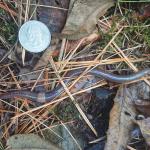 While it may be possible to purchase heat-treated compost or other materials, it is difficult to ensure that soils are entirely jumping worm free. Additionally, a land owner may already have jumping worms on their property without being aware of them. If one is especially concerned, purchasing bagged soils and mulches (that have been heated or can be heated in the bags to over 104°F for 3 or more days by placing on a hot surface in the sun) may be one way of preventing accidental transport of jumping worms. Purchasing local soils, composts, and mulches can also help reduce the potential distance these earthworms may move. The bottom line: unfortunately, there are limited prevention and even further limited management options for jumping worms available at this time.
While it may be possible to purchase heat-treated compost or other materials, it is difficult to ensure that soils are entirely jumping worm free. Additionally, a land owner may already have jumping worms on their property without being aware of them. If one is especially concerned, purchasing bagged soils and mulches (that have been heated or can be heated in the bags to over 104°F for 3 or more days by placing on a hot surface in the sun) may be one way of preventing accidental transport of jumping worms. Purchasing local soils, composts, and mulches can also help reduce the potential distance these earthworms may move. The bottom line: unfortunately, there are limited prevention and even further limited management options for jumping worms available at this time.
For more information about jumping worms and the latest research, visit these UMass Extension fact sheets:
- Earthworms in Massachusetts – History, Concerns, and Benefits
- Jumping/Crazy/Snake Worms – Amynthas spp.
- A Summary of the Information Shared at UMass Extension’s Jumping Worm Conference in January 2022
Tawny Simisky, Extension Entomologist, UMass Extension Landscape, Nursery, & Urban Forestry Program
Garden Clippings Tips of the Month
July is the month to . . . .
As the heat ramps up for summer there are many things to be done in the garden to keep things looking great and lay the foundation for a beautiful fall.
- Spent bulb foliage: Now is the time to cut back any remaining daffodil foliage as it turns yellow. The foliage should be left intact for as long as possible but has generally ripened sufficiently by early July.
- Shaping perennials: The last pinch to shape and encourage branching on late summer perennials should occur in early July. It’s still ok to thin stems on congested perennials to improve air circulation. Don’t be afraid to give a hard cut to catmint (Nepeta), lady’s mantle (Alchemilla mollis) and perennial geraniums (Geranium sp.) after the spring flush of flowering concludes.
- Container plants: Consider compost tea or organic liquid feed like fish emulsion or seaweed extract for container plants. Feed every 7-10 days. As the summer heats up and container plants fill their pots, twice a day watering might be necessary. Make sure to check the soil by inserting your finger into the first inch or so to see if the soil is moist. When watering containers water deeply (until water seeps out the bottom), to be sure all roots have access to moisture.
- Weeds: Catch weeds before they go to seed and continue to apply organic mulch to spots left bare by the removal of bulb foliage and/or weeds. Shredded leaves held over from fall cleanup make a wonderful mulch for annual and perennial borders as well as vegetable gardens. It’s natural, free, local and breaks down over the course of the growing season to add organic material to the soil.
- Peonies: Remove spent flowers from peonies once flowering is finished. If plants were staked or tied up to prevent flopping during bloom, the stakes and strings can now be removed providing stems are strong enough to stand on their own.
- Vegetable garden: Direct sow succession crops in your vegetable garden for the next round of harvest, such as radish, lettuce, carrots, chard, and beets. Side dress heavy feeders and long season crops like corn, tomatoes, squash, peppers, potatoes, onions and eggplant with a balanced fertilizer now.
- Biennials: Sow seeds of biennials like foxgloves, Angelica, Salvia sclarea, Lunaria and Dianthus now for planting in the garden in late summer. These will produce leaves this year, overwinter and flower next year, ending their life cycle when they set seed in their second season.
- Irrigation: Irrigate borders and lawns infrequently and deeply. Generally, lawns and gardens need 1” of water each week, or a deep irrigation that penetrates to 6”. Check your sprinklers using a tuna can to see how long it takes to apply 1” of water or, if using drip irrigation, time a run and use a trowel to see how deeply the water has penetrated. Keep track of rainfall using a rain gauge and supplement only as needed. Consider converting parts of your lawn to lower maintenance groundcovers, shrub or perennial borders, or meadow plantings.
- Japanese beetles: Depending on your location, Japanese beetles begin to emerge from the soil around July 4th. Keep a close eye out for them, scouting in the morning when they are sluggish and knocking them into a pail of soapy water. The solitary fly, Istocheta aldrichi, is an internal parastite of adult Japanese beetle. Female flies lay eggs on the thorax of female beetles. Upon hatching, the maggot bores into the beetle, killing it. Japanese beetles observed with these eggs on them should be saved to encourage this natrual control method.
- Fruit espalier: Lightly prune fruit tree espaliers to maintain shape and thin and/or reduce the length of upright growth. Tie cordons to frames or wires as wood begins to grow stiffer.
Joann Vieira, Director of Horticulture, Trustees
The Buzz on Mosquitoes
Picture this: A warm summer evening. A slight breeze. Hot dogs and burgers on the grill. You can hear a robin melodically singing good night, just as the sun begins to set. Everything is gre---
Bzzz – A mosquito zips by your ear. No doubt, that one is looking for a tasty sample of your blood. Nothing like mosquitoes to ruin your otherwise perfect night.
Mosquitoes aren’t just annoying, but they have the capacity to transmit disease. Mosquito-borne illnesses are not nearly as common as tick-borne illnesses. Some are exceedingly rare. However, they are still concerning as the consequences are, on average, far more severe. Contracting either West Nile Virus (WNV) or Eastern Equine Encephalitis Virus (EEEV) can result in death or lifelong effects.
Personal protection:
First, lets get through some of the personal protection methods. Although it’s been said again and again, I would be remiss if I didn’t review some of the more effective tools we have. Though no method will prevent 100% of bites, adding layers of protection will help to reduce bites and risk.
- EPA-registered repellents, like DEET and picaridin, are very effective at warding off most bites since they interfere with the mosquitoes’ ability to "smell" us. My personal favorite is picaridin because it doesn’t have as strong of a smell as DEET. This is also a good time to note that following the label for these products is the law.
- Covering up exposed skin can be another effective way to mitigate bites.
- Limit your activity between dusk and dawn. Mosquitoes can bite any time of day, but different species are active at different times. By limiting your activity between dusk and dawn, you can reduce your chances of contacting disease-transmitting species.
Now that’s out of the way… Let’s talk about some other ways you can manage mosquitoes by improving the practices you use in and around your yard. There are at least 51 species of mosquito here in Massachusetts, and they’re just as different from each other as you might imagine.
Managing water:
 One thing that all mosquitoes have in common is that the require water, and they need still water at that. As landscapers, we are constantly using water in various ways. I recommend either keeping water moving or emptying/replacing water on a weekly basis. Water can collect in a variety of locations that don’t easily spring to mind (see list below). Removing only obvious containers may “push” mosquitoes to lay eggs in more cryptic locations. Therefore, it’s important to reduce all potential sources.
One thing that all mosquitoes have in common is that the require water, and they need still water at that. As landscapers, we are constantly using water in various ways. I recommend either keeping water moving or emptying/replacing water on a weekly basis. Water can collect in a variety of locations that don’t easily spring to mind (see list below). Removing only obvious containers may “push” mosquitoes to lay eggs in more cryptic locations. Therefore, it’s important to reduce all potential sources.
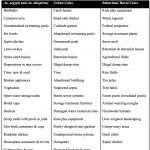 Here is a list of common locations where mosquitoes can breed:
Here is a list of common locations where mosquitoes can breed:
- Corrugated gutter extensions
- Pool covers
- Upside-down wheelbarrow lips
- Buckets
- Trash – tires, empty plastic cups, etc.
- Birdbaths
- Potted plant saucers
Mosquito-repelling plants
Some plants contain essential oils that can provide repellency. In order to achieve effective levels of protection, the volatile oils need to be released. This can generally be accomplished by crushing or heating the leaves. So far, there’s no convincing evidence that simply growing plants (and not crushing/heating their leaves) will achieve effective levels of repellency.
Landscape design:
The design of your landscape could determine which types of mosquitoes are present and in what abundance. Many types of mosquitoes prefer shady, vegetated areas where environmental conditions may be more favorable. Gardner et al. 2013 found higher populations of mosquitoes associated with these locations. Does this mean opening up your lawn and cutting back trees can reduce mosquitoes? Maybe. But we should wait for additional research on the topic to inform us.
Reduce artificial light at night
Low levels of light may increase mosquito bites more than high levels or no light at all. Bug “zappers” are also not recommended. No controlled study has shown them to be effective. Sure, you may hear plenty of zzzps, but these are likely not mosquitoes they are killing. Save energy. Save fireflies. Save moths. AND reduce mosquito bites. All by reducing artificial light at night? At least this one seems like a no-brainer.
Citations:
AMCA. 2021. Best Practices for Integrated Mosquito Management. American Mosquito Control Association. Sacramento, CA. Updated November 2021.
Dowling, Z., Ladeau, S. L., Armbruster, P., Biehler, D., & Leisnham, P. T. (2013). Socioeconomic status affects mosquito (Diptera: Culicidae) larval habitat type availability and infestation level. Journal of Medical Entomology, 50(4), 764-772.
Gardner, A. M., Anderson, T. K., Hamer, G. L., Johnson, D. E., Varela, K. E., Walker, E. D., & Ruiz, M. O. (2013). Terrestrial vegetation and aquatic chemistry influence larval mosquito abundance in catch basins, Chicago, USA. Parasites & vectors, 6(1), 1-11.
Hill, N., Lenglet, A., Arnez, A. M., & Carneiro, I. (2007). Plant based insect repellent and insecticide treated bed nets to protect against malaria in areas of early evening biting vectors: double blind randomised placebo controlled clinical trial in the Bolivian Amazon. bmj, 335(7628), 1023.
Kernbach, M. E., Martin, L. B., Unnasch, T. R., Hall, R. J., Jiang, R. H., & Francis, C. D. (2021). Light pollution affects West Nile virus exposure risk across Florida. Proceedings of the Royal Society B, 288(1947), 20210253.
Seyoum, A., Killeen, G. F., Kabiru, E. W., Knols, B. G., & Hassanali, A. (2003). Field efficacy of thermally expelled or live potted repellent plants against African malaria vectors in western Kenya. Tropical Medicine & International Health, 8(11), 1005-1011.
Unlu, I., Faraji, A., Indelicato, N., & Fonseca, D. M. (2014). The hidden world of Asian tiger mosquitoes: immature Aedes albopictus (Skuse) dominate in rainwater corrugated extension spouts. Transactions of The Royal Society of Tropical Medicine and Hygiene, 108(11), 699-705.
Westby, K. M., Adalsteinsson, S. A., Biro, E. G., Beckermann, A. J., & Medley, K. A. (2021). Aedes albopictus populations and larval habitat characteristics across the landscape: Significant differences exist between urban and rural land use types. Insects, 12(3), 196.
Yang, L., Turo, K. J., Riley, C. B., Inocente, E. A., Tian, J., Hoekstra, N. C., ... & Gardiner, M. M. (2019). Can urban greening increase vector abundance in cities? The impact of mowing, local vegetation, and landscape composition on adult mosquito populations. Urban Ecosystems, 22(5), 827-839.
Blake Dinius, Entomologist, Plymouth County
Upcoming Events
For more details and registration options for upcoming events, go to the UMass Extension Landscape, Nursery, and Urban Forestry Program Upcoming Events Page.
- 6/30/22 - Registration begins for the 2022 Green School. For complete details and registration options, go to https://ag.umass.edu/landscape/education/umass-extensions-green-school
- 10/18/22 - Deadline for registering for Green School
Pesticide Exam Preparation and Recertification Courses
These workshops are currently being offered online. Contact Natalia Clifton at nclifton@umass.edu or go to https://www.umass.edu/pested for more info.
InsectXaminer!
Episodes so far featuring gypsy moth, lily leaf beetle, euonymus caterpillar, imported willow leaf beetle, and spotted lanternfly can be found at: https://ag.umass.edu/landscape/education-events/insectxaminer
TickTalk with TickReport Webinars
To view recordings of past webinars in this series, go to: https://ag.umass.edu/landscape/education-events/ticktalk-with-tickreport-webinars
Additional Resources
For detailed reports on growing conditions and pest activity – Check out the Landscape Message
For professional turf managers - Check out our Turf Management Updates
For commercial growers of greenhouse crops and flowers - Check out the New England Greenhouse Update website
For home gardeners and garden retailers - Check out our home lawn and garden resources.
Diagnostic Services
Landscape and Turf Problem Diagnostics - The UMass Plant Diagnostic Lab is accepting plant disease, insect pest and invasive plant/weed samples . By mail is preferred, but clients who would like to hand-deliver samples may do so by leaving them in the bin marked "Diagnostic Lab Samples" near the back door of French Hall. The lab serves commercial landscape contractors, turf managers, arborists, nurseries and other green industry professionals. It provides woody plant and turf disease analysis, woody plant and turf insect identification, turfgrass identification, weed identification, and offers a report of pest management strategies that are research based, economically sound and environmentally appropriate for the situation. Accurate diagnosis for a turf or landscape problem can often eliminate or reduce the need for pesticide use. See our website for instructions on sample submission and for a sample submission form at https://ag.umass.edu/services/plant-diagnostics-laboratory. Mail delivery services and staffing have been altered due to the pandemic, so please allow for some additional time for samples to arrive at the lab and undergo the diagnostic process.
Soil and Plant Nutrient Testing - The lab is accepting orders for Routine Soil Analysis (including optional Organic Matter, Soluble Salts, and Nitrate testing), Particle Size Analysis, Pre-Sidedress Nitrate (PSNT), and Soilless Media (no other types of soil analyses available at this time). Testing services are available to all. The lab provides test results and recommendations that lead to the wise and economical use of soils and soil amendments. For updates and order forms, visit the UMass Soil and Plant Nutrient Testing Laboratory web site.
Tick Testing - The UMass Center for Agriculture, Food, and the Environment provides a list of potential tick identification and testing options at: https://ag.umass.edu/resources/tick-testing-resources.

